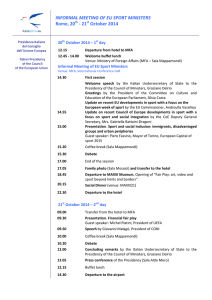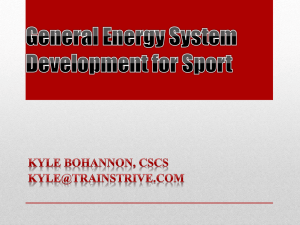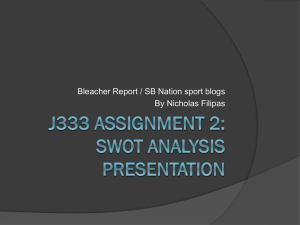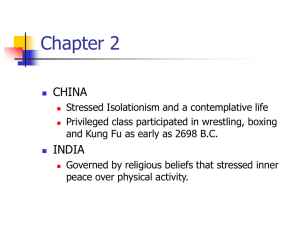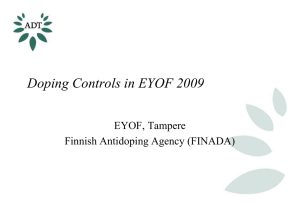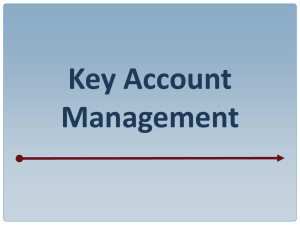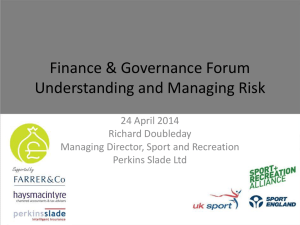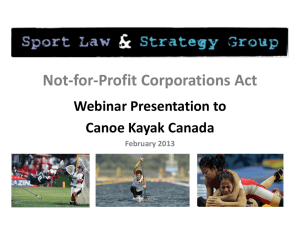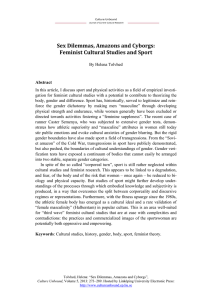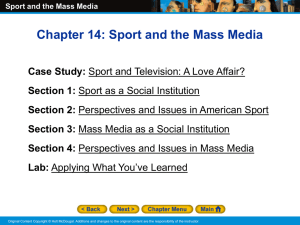Main Differences - Australian University Sport
advertisement
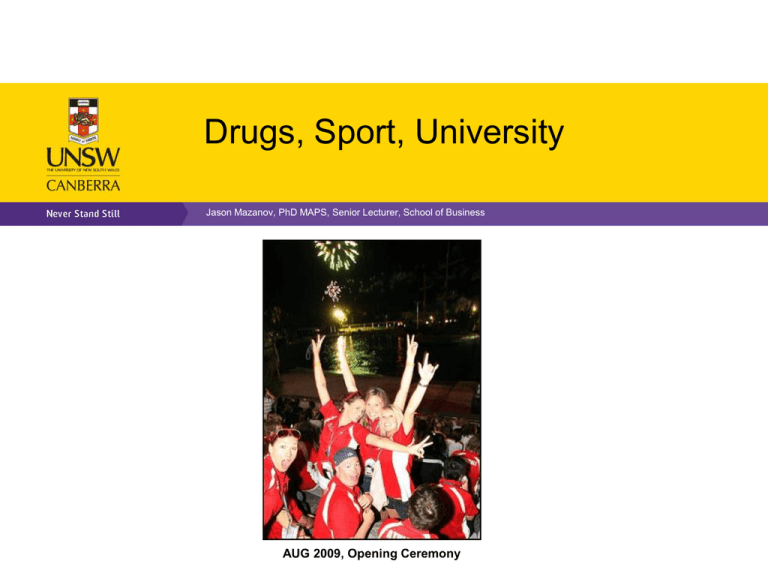
Drugs, Sport, University Jason Mazanov, PhD MAPS, Senior Lecturer, School of Business AUG 2009, Opening Ceremony An Overview of Drugs in Sport Licit Drugs Supplements Prescription Substances Caffeine Alcohol Use Misuse Abuse Doping Illicit Drugs Erythropoietin (EPO) Human Growth Hormone (HGH/IGF1) Androgenic Anabolic Steroids (AAS) Beta Agonists Genetic Manipulation Cocaine Amphetamines Marijuana A Brief History of Drugs in Sport • • • • • • • • Ancient Olympics Gladiators Victorian England Sport – The Laboratory of Natural Science The Rise of Pharmacology World War 2 The Decline of Amateurism The Rise of Sport Science Mazanov & McDermott, 2009 A Brief History of Drugs and Sport • Socialising - the Germanic tradition • Deterrence hypothesis – sport protects participants from drugs • Winning – the Cold War, amateurism and sport science • Sponsorship – tobacco, alcohol and supplements • Self-medicating – coping with sport, recovery A Note on the Deterrence Hypothesis... Sport Protects People From Tobacco (excl. Baseball) Range of Illicit Drugs Alcohol Abuse Doping Sport Makes People Vulnerable to Dunn et al, 2011; Lisha & Sussman 2010 A Brief History of Drug Control in Sport 1920s - Debate role of drugs in sport (incl. Hypnosis) 1950s – Coherent anti-drug policies begin to emerge 1967 – Cyclist Tommy Simpson dies; antidoping born 1968 – First IOC drug tests (alcohol) 1970s/80s – Anti-doping cynically administered by IOC 1988 - Seoul Olympics Men’s 100m Final 1989 – Dubin Commission/Black Inquiry 1990 - ASDA 1998 - Tour de France/World Swimming Championships 2003 - World Anti-Doping Agency 2003 2006 – ASADA 2013 – Lance Armstrong/ACC Report Mazanov & McDermott, 2009 Anti-Doping: Protecting the Integrity of Sport • WADC 2003, 2009, 2015 • “to protect the integrity of sport” (Mazanov & Connor, 2010) • Defines doping as contrary to Olympism via “Spirit of Sport” • 8 ADRV – 2 for a drug test, 6 administrative • Athlete, coach, trainer, manager, agent, team staff, official, medical, paramedical, parent or any other person Spirit of Sport Aggregate Male Female Do Not 168 85 83 19 Ethics, fair play and 4.072 (1) 4.975 3.536 3.000 (1) Health 1.161 (7) 1.240 1.083(7) 2.380 (2) Excellence in performance 0.439 (8) 0.482 0.396 0.354 (10) Character and education 0.426 (9) 0.515 0.330 0.500 (8) Fun and joy 1.177 (6) 1.020 1.387(5) 1.026 (6) Teamwork 1.551 (4) 1.438 1.689 0.894 (7) Dedication and commitment 1.178 (5) 1.166 1.191 1.348 (5) Respect for rules and laws 1.807 (3) 2.032 1.612 1.563 (4) Respect for self and other 4.024 (2) 3.296 5.431 1.944 (3) Courage 0.336 0.342 0.330 0.302 (11) Community and solidarity 0.378 0.314 0.445 0.488 (9) N Mazanov, Huybers & Connor, 2012 Drug Testing • Nipple to knee • Doping control officer • Paruresis (Elbe et al, 2012) • Applies to any athlete Athlete Whereabouts • Athletes must be available for Out-of-Competition testing • 3 months, in advance, nominate a location they will be at for 1 hour per day they will be available for drug testing (incl. Christmas) • Being unavailable results in sanction • Threats to freedom of movement, autonomy, privacy (Malloy & Zuckus, 2002) • Control order usually reserved for paedophiles/terrorists (Waddington, 2010) • Subject of case in European Court of Human Rights ASP Sanctions • ASP get general idea, no idea how it works (Mazanov et al, 2013) • TKD trainer at Canadian National Championships • Gave 16 year old banned diuretic by mistake • 5 year ban • No record of ASP sanction in Australia • Sport science in focus Critique of Anti-Doping • Drugs inimical to modern sport • Doping scandal good for business • Unlikely to ever win the war on drugs in sport (Fahey, 2013) • No definition of Spirit of Sport (Mazanov et al, 2012) • Drug testing inherently flawed (epidemiology unknown) • Individually rather than institutionally focused • Impugns human rights to protect private institutional interest • Intensely complicated system (biochemists; XZTT) • Focus on elite sport at expense of everyone else • Focus on doping at expense of other drugs • Fails to manage the role of drugs in sport (Mazanov, 2013) • Need a new approach to manage drugs in sport Drug use in University Sport • We know very little about “doping” in non-elite sport • Would love to do the research, need access and funding • Substances of threat in university sport: • • • • • Alcohol Caffeine abuse Contaminated supplements Protein abuse Prescription amphetamines Drug use in University Sport • Extension of Huybers & Mazanov (2012) • Model fit Elite Athletes 0.169 (good), University Athletes 0.028 (bad) • University athletes think about doping differently to elite athletes • Different drug management required wrt doping Main Differences Injury or Performance has no impact on use More sensitive to contracts Health impacts irrelevant No impact for small fines No impact for other penalties Managing Drug Use in University Sport • Three groups: abstain, use, maybe • Focus on drug use rather than doping • Cycling Australia Review • Active rather than passive drug management • Health less of an issue in elite sport • Folly of punishing A while hoping for B • Education around sports ethics – why rather than comply • Education around what can be used safely and how Doping in Sport, Doping in Society • Performance enhancing substance use a societal phenomenon • Ballet dancers, military, emergency services, truck drivers, surgeons, academics • Cognitive enhancing drug use in universities • Sport a good testing ground before broader regulation

